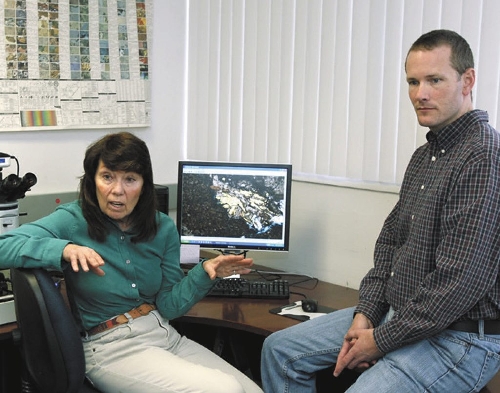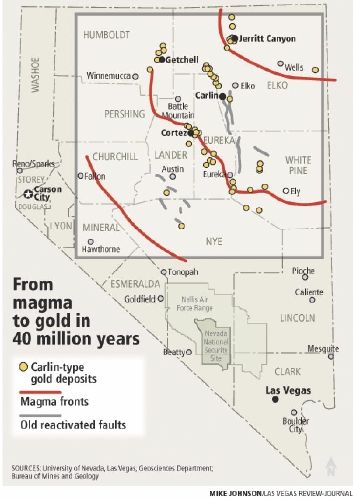Gold gave Nevada second-largest deposits in world
For 50 years scientists argued over how a swath of microscopic gold -- the nation's largest deposit and second only to South Africa -- formed under Northern Nevada.
Now, UNLV and state geologists think they have an explanation for this "invisible" gold. They say their research, if applied to other parts of the country and around the world, could help mining companies find similar deposits.
Hot, gold-bearing fluids welled up from deep in the Earth along fault lines and fractures and left their riches to be found some 40 million years later, according to the team's study, which was peer-reviewed and published in Nature Geoscience.
The largest deposits, named after the town of Carlin outside Elko off Interstate 80, are dug from open-pit mines at four main locations.
The ore is hauled from the pits and some underground mines by big trucks. Then it is crushed and treated with a cyanide solution that dissolves tiny particles of gold that can be extracted and recovered by processes that absorb it or precipitate it.
These so-called Carlin-type deposits contain more than 6,000 metric tons of gold.
For comparison, total gold production from Nevada between 1835 and 2008 totaled 4,700 metric tons, which is worth about $180 billion at 2010 prices, according to one of the study's co-authors, Adam Simon, assistant professor for economic geology and geochemistry in UNLV's Geoscience Department.
The geologists from the University of Nevada, Las Vegas, the University of Nevada, Reno and the state Bureau of Mines and Geology published a peer-reviewed model showing how these Carlin-type deposits arrived at their current locations from a journey that began in magma, or deep molten rock mixed with solids and gases.
"There have been multiple raging debates about these deposits in the 1980s and 1990s," UNLV geology professor Jean Cline, another co-author of the report, said about the origin of Nevada's Carlin-type gold deposits.
"We think we put together the first comprehensive model, the first data set, that explains this," Cline said. "Before, there wasn't really good evidence to say it's this or that."
The article was published online Jan. 23 by Nature Geoscience and in print as the journal's Feb. 11 cover story.
In a recent interview, Cline and Simon explained how they brainstormed scenarios on the origin of invisible gold during a retreat two years ago with the report's other authors, UNLV's Anthony Longo and John Muntean of the Bureau of Mines and Geology.
"We spent three days and two nights. We ate and slept thinking about this and divided up the questions and sorted out the answers," Cline said about the retreat at Walking Box Ranch near Searchlight.
Simon said the model began to take shape after they "thought outside of the box and were able to expand our horizons."
They realized that determining the age of minerals associated with Carlin-type gold deposits would be key to locating their source relevant to geologic features such as earthquake faults and breccias, a type of sedimentary rock with fragments cobbled together in a mass of fine-grain material.
The linchpin in their work turned out to be pyrite, an iron-sulfide mineral commonly known as "fool's gold."
"Most of the time it's fool's gold, but not in this case," Cline said.
In fact, pyrite is the host of the microscopic gold particles.
Carlin-type deposits are different from visible gold that formed in rock veins like quartz after ore fluids rose through Earth's crust, leaving behind gold nuggets that precipitated from hot vapors.
Instead, Cline said, invisible gold stems from magma that rose from 25 miles deep to about six miles to eight miles beneath the surface.
Hot, gold-rich fluids continued to rise along faults left by massive tectonic plate movements that occurred in what is now Northern Nevada near Carlin from about 37 million years ago to 41 million years ago.
According to Simon, the activity along rock-mass fractures was akin to jelly squeezing along the edges of two slices of bread that have been slammed together.
The hot water -- or fluids containing gold and other elements including arsenic, antimony, copper and sulfur -- combined with an iron rock layer to make pyrite.
When pyrite precipitated as the fluids cooled about one mile to 1½ miles beneath the surface, gold and other metals were left dispersed in clays, soils and rock materials.
In some places on the planet, gold is more concentrated than others.
"In your backyard there is gold at one part per billion," Simon said. "In the Carlin trend, gold is several parts per million. So there's not enough to dig for in your backyard."
At several parts per million, Newmont Mining geologist John S. Livermore and geochemist Alan Coope discovered the deposits and staked claims for the Carlin Mine in October 1961. They knew there was enough invisible gold ore there for a profitable mining venture.
Simon said the team's model "will help mining companies look for new deposits on long, linear trends where multiple, mountain-building events have occurred and fluids are able to come up."
Contact reporter Keith Rogers at krogers@ reviewjournal.com or 702-383-0308.


















